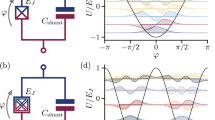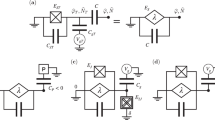Abstract
One of the important predictions of the early phenomenological theories of superconductivity such as the London and Ginzburg–Landau (GL) theory is the quantization of magnetic flux in multiply connected superconductors, which is one of the first demonstrations of a quantum effect on a macroscopic scale. In this paper, which is devoted to Vitalij Lazarevich Ginzburg on the occasion of his 90th birthday, we analyze a superconducting cylinder acting as a flux box as well as a superconducting disk acting as a Cooper pair box in the framework of GL theory. We extend this analysis to leaky flux and Cooper pair boxes which are obtained by introducing weak links allowing for the entry and exit of flux quanta and Cooper pairs from the respective boxes at finite rates. Flux and Cooper pair slippage processes by coherent quantum tunneling result in effective two-level quantum systems forming the basis for flux and charge quantum bits presently considered for the solid-state implementation of quantum information processing. We show that the corresponding Hamiltonians describing the leaky flux and Cooper pair box can be transformed into each other by a canonical transformation.
Similar content being viewed by others
References
F. London and H. London, Proc. R. Soc. (London) A 149, 71 (1935); see also F. London, Superfluids (Wiley, New York, 1950).
V. L. Ginzburg and L. D. Landau, Zh. Eksperim. I. Teor. Fiz. 20, 1064 (1950).
J. Bardeen, L. N. Cooper, and J. R. Schrieffer, Phys. Rev. 108, 1175 (1957).
R. Doll and M. Näbauer, Phys. Rev. Lett. 7, 51 (1961).
R. Doll and M. Näbauer, Z. Phys. 169, 526 (1962).
B. S. Deaver and W. M. Fairbank, Phys. Rev. Lett. 7, 43 (1961).
W. A. Little and R. D. Parks, Phys. Rev. Lett. 9, 9 (1962); see also Phys. Rev. 133, A97 (1964).
R. Doll and D. Einzel, J. Supercond. Nov. Mag., this issue.
B. D. Josephson, Phys. Lett. 1, 251 (1962).
R. C. Jaklevic, J. Lambe, A. H. Silver, and J. E. Mercereau, Phys. Rev. Lett. 12, 159 (1964).
J. Clarke, Philos. Mag. 13, 115 (1966).
J. E. Zimmermann, P. Thiene, and J. T. Harding, J. Appl. Phys. 41, 1572 (1970).
J. Clarke and A. I. Braginski (eds.), The SQUID Handbook, Vol. 1: Fundamentals and Technology of SQUIDS and SQUID Systems (Wiley-VCH, Weinheim, 2004).
J. E. Mooij, T. P. Orlando, L. Levitov, L. Tian, C. H van der Wal, and S. Lloyd, Science 285, 1036 (1999).
C. H. van der Wal, A. C. J. ter Haar, F. K. Wilhelm, R. N. Schouten, C. J. P. M. Harmans, T. P. Orlando, S. Lloyd, and J. E. Mooij, Science 290, 773 (2000).
J. R. Friedman, V. Patel, W. Chen, S. K. Tolpygo, and J. E. Lukens, Nature 406, 43 (2000).
Y. Nakamura, Y. A. Pashkin, and J. S. Tsai, Nature 398, 786 (1999).
Y. Makhlin, G. Schön, and A. Shnirman, Rev. Mod. Phys. 73, 357 (2001).
D. Vion, A. Aassime, A. Cottet, P. Joyez, H. Pothier, C. Urbina, D. Esteve, and M. H. Devoret, Science 296, 886 (2002).
T. Yamamoto, Yu. A. Pashkin, O. Astafiev, Y. Nakamura, and J. S. Tsai, Nature (London) 425, 941 (2003).
R. Doll and P. Graf, Z. Phys. 197, 172 (1966).
C. N. Lau, N. Markovic, M. Bockrath, A. Bezryadin, and M. Tinkham, Phys. Rev. Lett. 87, 217003 (2001).
J. E. Mooij and Yu. V. Nazarov, Nat. Phys. 2, 169 (2006).
J. E. Mooij and C. J. P. M. Harmans, New J. Phys. 7, 219 (2005).
M. Tinkham, Introduction to Superconductivity (McGraw-Hill, New York, 1996).
Author information
Authors and Affiliations
Corresponding author
Additional information
PACS numbers: 74.20.De, 74.25.Bt, 74.25.Ha, 74.50.+r
Rights and permissions
About this article
Cite this article
Gross, R., Marx, A. & Einzel, D. From Flux Quantization to Superconducting Quantum Bits. J Supercond 19, 331–340 (2006). https://doi.org/10.1007/s10948-006-0167-6
Published:
Issue Date:
DOI: https://doi.org/10.1007/s10948-006-0167-6




